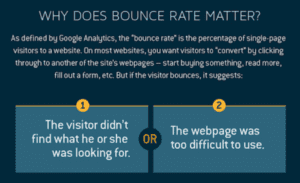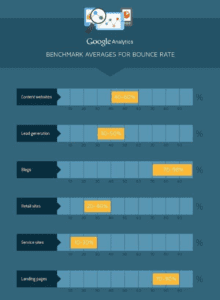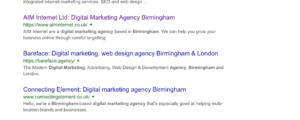It’s time to learn the best ways to reduce your websites bounce rate and increase conversion and sales.
But before we begin, what exactly is bounce rate?
Bounce rate is the percentage of single page visits (or web sessions). It is the percentage of visits in which a person leaves your website from the landing page without browsing any further.
Contact Us
While its definition seems straightforward enough, often the reason for a bounce isn’t as simple. Bounce rate is known as one of the most misunderstood metrics in Google Analytics, this is because a high bounce rate can actually be a sign of both poor user experience and great user experience. Confusing right?
In order to understand your website bounce rate you need to take a look at all your web pages and make sure they are working for you and not against you.
Google defines a bounce as a “single-page session on your site.” Bounce rate is the percentage of single-page sessions compared to all sessions on your website.
For example, if a visitor clicks through to read a blog post but then doesn’t visit any other pages on your website before exiting, this is classed as a bounce. This means that if eight out of ten users only visit the one page of your site, your bounce rate is 80%.
Chances are, you will use Google to measure your bounce rate so it’s good to know how Google defines it:
In Analytics, a bounce is calculated specifically as a session that triggers only a single request to the Analytics server, such as when a user opens a single page on your site and then exits without triggering any other requests to the Analytics server during that session.
Importance of measuring bounce rate
Measuring your websites bounce rate is important, by asking the right questions surrounding it; you can increase your conversion rate and sales. So what question should you be asking?
Why is my bounce rate so high?
According to hubspot, if your bounce rate is high then it’s because the user doesn’t want to stick around on your site, which isn’t a good thing.

If people are not hanging around on your website then it’s highly unlikely that they will make a purchase or complete any other kind of conversion.
However, as we mentioned before, it’s not always as simple as that. What if a visitor arrives on your page looking for the answer to a particular question, they find that answer then leave? This will still reflect in your bounce rate, yet the user found exactly what they were looking for, which means in theory, they’ve had a great user experience. So, how do you know when bounce rate is good and when it’s bad?
What is a good bounce rate?
If you’re going to track bounce rate, you should do it based on the content of your pages. Blog posts, for example, usually generate a high number of bounces for the reason we covered above.
An e-commerce site on other hand is likely to have, and should have a much lower bounce rate from people browsing the multiple pages and products.
HubSpot also suggests that the average bounce rate based on page type is as follows:

Jakob Nielson, a well-known usability researcher breaks it down even further. He highlights the importance of understanding how visitors arrive on your pages, and believes the traffic source is just as important as page type when it comes to bounce rate. For example, search engine traffic is likely to result in a lower bounce rate as a user in actively looking for what you are offering.
The following things are also important to keep in mind when measuring bounce rate for your site:
-
User intent / behaviour
How are people interacting with your website? If people are not moving past your landing page then chances are you’re not giving them what they want, which means they’ll bounce from your page.
Unless of course, you are not asking the user to click further through your site. On the other hand, a user may also bounce even if they’re satisfied with their findings on the landing page but again, it also means you didn’t give them a reason to continue clicking through.
-
Type of website
Different types of websites will of course have a different bounce rate. For example if your website is a purely for blogging purposes, then it’s not unusual for users to visit your website then leave, resulting in a high bounce rate. Similarly, if you have a single page website then your bounce rate will be very high, possibly even 100%.
However, there are still ways to keep a user on your site even if it’s a blog. For example, guide them to the bottom of the blog post where they can click through to read another blog they may be interested in. Or, you can also do this in the body of your content. You’ll notice throughout this article that there are various hyperlinked phrases that give you the option of navigating to more pages you might like.
-
Type of landing page
Depending on which page the user is looking for and lands on will also depend on how long they continue to browse through. If the visitor lands on the contact us page, then they are likely looking for contact information so will not need to continue clicking through.
-
Quality of the landing page
A landing page needs to be attractive, clean, appealing and with a clear call to action to ensure a user stays on your page, let alone continues browsing. If your landing page is messy and unclear then this will result in a high bounce rate.
-
Type of content
Any content on your landing page must also be easy to read and easy to digest otherwise it will be off putting for users. Long blocks of text that is difficult to read may mean a user needs to digest in more than one visit or it could put them off all together.
-
Type of industry
Bounce rate also varies from industry to industry so it’s important to analyse your industry average to ensure you’re investing time and money into the right strategy areas.
-
Quality of traffic
To get an accurate analysis of your bounce rate you need to ensure you’re attracting the right audience. If you are getting the wrong type of traffic to your website, then this will naturally mean a high bounce rate.
-
Type of marketing channel
Different marketing channels and how users arrive on your site will also result in varying bounce rates. Bounce rate from social media traffic for example, tends to be higher than the bounce rate of organic traffic. This is because organic traffic is more like to be the right target audience.
-
Visitor type
Returning visitors are less likely to bounce than new visitors. Returning visitors know your brand, and if they’re returning then it’s often because they already want something.
-
Device type
Bounce rate also varies from device to device. If your website is being accessed by mobile for example, and your website isn’t mobile friendly (which by now it really should be, we shouldn’t have to stress the importance of this) then your bounce rate will be much higher due to poor user experience. Failing to optimise your site for mobile is as good as personally directing your customers to your competitors website.
If after you have carefully analysed your web pages and your key website objectives, your website’s bounce rates are still higher than you’d like them to be, there are a few things you can do to reduce them.
-
Speed up your page’s load time
You may have seen our recent article on the importance site speed and page load time. Site speed is how long it takes for users to see your website content and interact. Users do not like to wait, which means a long page load time is a key instigator of a high bounce rate. Data shows that 53% of visitors will abandon a page if it doesn’t load in 3 seconds.
-
Optimise for the right keywords
When a user is looking for something online, the first thing they will do is enter keywords into the search engine. This brings up a search engine results page with answers to their search in the format of snippets (also known as the page’s title tag and meta description).

It’s important to ensure you have optimised your website for these keyword searches before you publish your web page. Make sure that its title tag and meta description accurately represent the content of the page. If visitors clicking through don’t land on a page relevant to their search, they’ll bounce.
-
Keep your web pages simple
Research has shown that people form an opinion about a website even quicker than they form a first opinion of another human being. (We all know we’re guilty of it.) The key to a good first impression is surprisingly easy: simplicity.
No one likes a home page or landing page that is cluttered with difficult to digest content or confusing navigation. When a visitor arrives on your page it should be easy for them to:
Find information quickly
If they searched “how to convert your blog readers into customers” and the page is about something completely different then they’re likely to be frustrated, resulting in a quick exit and another bounce.
Navigate your website quickly and easily
Your website should be simple and straightforward for a user to navigate making their experience effortless while clicking through the pages.
Trust your brand and your content.
As general rule, (and we can all vouch for this) user experience can be tarnished if you’re bombarded with ads and popups, it can also reduce the trust between brand and customer. Make sure you don’t compromise user experience in the process of trying to make more money – in the long term it won’t work.
As previously mentioned, ensuring your content is readable and easily digestible is key to reducing your bounce rate. Large chunks of solid content should be avoided as to not scare off your customers. An easy way to do this is to:
- Use subheadings to break it down and clearly label throughout what the content is about.
- Use bullet points to make key points clear and easy to read.
- Use images, screenshots and quotes where appropriate.
- Ensure key words stand out from the rest of the text.
- Ask questions within your content so that readers can interact, so to speak.
A final key thing to reiterate when it comes to reducing your bounce rate is clear calls to action.
You need to consider exactly what action you want users to take when they’ve consumed your content and put steps in place to lead them there. The best way to do this is by including one, clear as day call to action. Too many can be confusing or overwhelming.
Your site should make it effortless for users to find and do exactly what they want quickly and easily.
Conclusion
Although your website is there to make you money (in a lot of instances), this shouldn’t be your main objective when working towards that. The key to success is always the same; deliver the best user experience you can. Your focus shouldn’t be on optimising for bounce rate, but improving the user experience. Once you have achieved this, your bounce rate will organically improve. The easier, more interesting and more relevant your content is to access and to the customer, the more pages they’re likely to visit.
If you would like some more advice on how to reduce your website’s bounce rate then our experts at AIM Marketing would love to help. Call us today on 0207 856 0418 or send us an email at at info@aiminternet.co.uk to see how we can help convert your blog readers into sales.
If you found this article useful you may also like to read our previous post on How to Covert Your Blog Readers into Customers.

